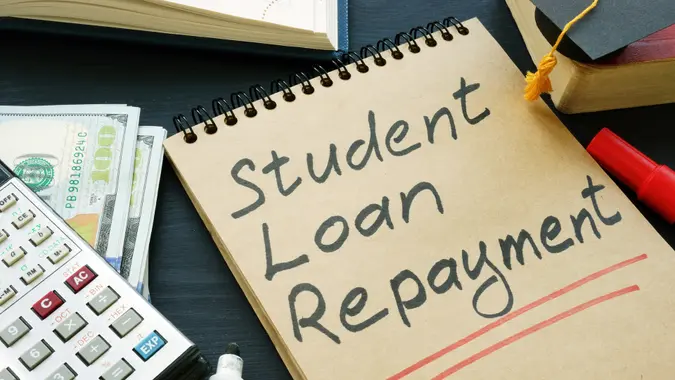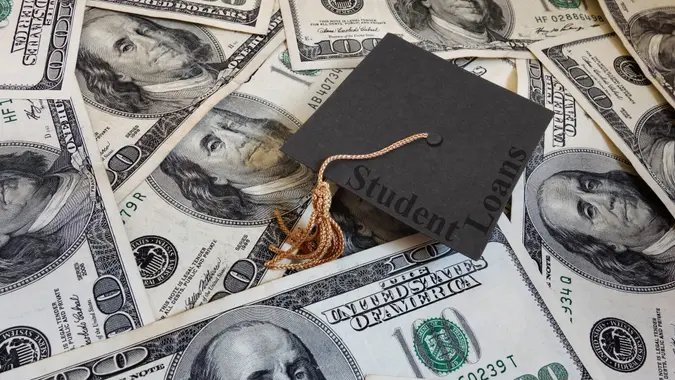How to Apply for Student Loans

Commitment to Our Readers
GOBankingRates' editorial team is committed to bringing you unbiased reviews and information. We use data-driven methodologies to evaluate financial products and services - our reviews and ratings are not influenced by advertisers. You can read more about our editorial guidelines and our products and services review methodology.

20 Years
Helping You Live Richer

Reviewed
by Experts

Trusted by
Millions of Readers
For most Americans, higher education is out of reach without taking on some debt. According to Pew Research, one in four U.S. adults under 40 have student loan debt.
Whether you’re interested in federal student aid or private student loans, these steps will help smooth out the process when it comes time to apply for a loan.
Types of Student Loans
There are two main types of student loans: federal and private. Like the names suggest, federal loans are managed by the government and private loans are managed by banks. The terms for federal loans are often better and come with lower interest rates and delayed payment times.
Federal Student Loans
There are three different federal loans available:
- Direct subsidized loan: Meant for undergraduate students with financial need
- Direct unsubsidized loans: Meant for undergraduate, graduate or professional students. Financial need isn’t a consideration.
- Direct PLUS loans: Meant for graduate or professional students or parents of undergraduate students.
Private Student Loans
According to FinAid, sometimes, your tuition costs are more than what the government offers you. In that case, many choose to fill the gap with private student loans. The terms will depend on the bank you borrow from.
| Feature | Federal Student Loans | Private Student Loans |
|---|---|---|
| Eligibility | FAFSA Determines amount neededNo credit check, except for PLUS loans. | Requires credit checkMay require a cosigner |
| Interest Rates | Fixed by the government | Can be variable of fixed, determined by lender |
| Repayment Options | Income-driven repaymentSome people are eligible for repayment and forgiveness | Limited flexibility |
| Loans Limits | Capped based on degree level and dependency status | Depends on lenderDepends on borrower’s creditworthiness |
| Subsidized Options | Government pays while you’re in school | Not available |
Steps to Apply for a Federal Student Loan
The process for applying for student loans can take some time, but understanding the necessary steps can help you be more efficient. Here are the steps you need to take to apply for school loans:
1. Determine Your Need
When trying to determine how to pay for college, remember there are more expenses than just tuition. Figure out how much you’ll need to borrow by researching the total cost of getting your degree.
Include the estimated cost of the necessary expenses, such as:
- Books and supplies
- Tuition and fees
- Room and board
- Transportation
- Other personal expenses
Consider how much money you have available to pay for these expenses, including any contributions from your parents. That amount is your expected family contribution. Subtract your EFC from your anticipated expenses to determine how much extra you’ll need to cover the cost of your college education.
2. Apply for FAFSA
The first step in applying for financial aid at most colleges and universities is filling out the Free Application for Federal Student Aid. FAFSA is the key that unlocks access to $150 billion in federal grants, work-study funds and loans each year, and it’s used by many state and private colleges to determine eligibility for aid. Grants and work-study funds don’t require repayment, and can significantly reduce the amount of money you need to borrow to fund your education.
Documents You’ll Need
You’ll need to gather some basic information and documents before filling out FAFSA. Be prepared to complete your form with the following details:
- Your Social Security number or alien registration number
- Your most recent federal income tax returns, W-2s, and other records of money earned
- Bank statements and records of investments
- Records of untaxed income
If you’re a dependent student you’ll need to provide the same information from your parents.
3. Decide Which Type of Loan Is Best for You
Your FAFSA results will determine which loans you qualify for. You might find you’re eligible for one or more of the following:
- Subsidized Stafford loans: Need-based loans that the government pays interest on while the student is in school and until repayment begins
- Unsubsidized Stafford loans: Loans not based on income and which students are responsible for repaying interest on
- Perkins loans: Offered in cases of extraordinary need, in which the school, not the federal government, is the lender
Before deciding on the type and amount of loan to take, consider how you’re going to pay it back. Ask about any available student loan forgiveness plans that might be available, and make a plan for student loan repayment that won’t put you in a financial bind once your loan payments become active.
4. Meet With Your School’s Financial Aid Office
Your completed FAFSA will tell you what federal financial aid, including student loans, you qualify for. But your college or university’s financial aid office is responsible for helping students apply for and receive student loans, grants, scholarships and other types of financial aid.
Your financial aid officer can provide information about additional scholarships, grants, private student loans, and aid that’s school- or state-specific.
How to Apply for Private Student Loans
Private student loans take a bit more leg work.
Step 1: Research and Compare Lenders
Make sure you understand the loan terms, including:
- How much interest will cost
- When you are expected to start paying interest
- When you are expected to start paying the loan back (this could be before you finish school)
Step 2: Understand Your Eligibility
Check your credit score to help you understand what kind of loans you qualify for. This will also help you determine if you need a cosigner.
Step 3: Submit Your Application
If you’re applying for private student loans from a bank or third-party lender, you’ll need additional documentation to meet the lender’s requirements, such as a driver’s license to prove your identity and paycheck stubs to verify your employment history..
Step 4: Review and Sign the Agreement
Read your loan terms closely. Make sure you understand all of the repayment expectations.
Federal vs. Private Student Loans: Which One Is Right for You?
Depending on how much money you need for school, you might have to apply for both. It’s best to apply for federal loans first, since the terms are usually better. Then, if you still need more money to cover your school expenses, apply for private loans. But at its core, a student loan is still a loan. It’s borrowed money that must be repaid with interest. When you have a repayment plan in mind before you sign for a loan, you can help prevent excess financial stress once that monthly student loan payment becomes due.
FAQ
- Can I apply for both federal and private student loans?
- Yes.
- Do I need a cosigner for private student loans?
- You might, depending on the lender and your credit history. Younger people often have shorter credit histories, which makes it difficult for them to get approved for loans on their own.
- When do I start repaying my student loans?
- Federal student loans won’t need to be repaid until after you graduate. For private loans, you may have to pay interest and the loan during school.
- Can I refinance my student loans later?
- Yes.
- How do I check the status of my loan application?
- You’ll need to contact the lender.
Our in-house research team and on-site financial experts work together to create content that’s accurate, impartial, and up to date. We fact-check every single statistic, quote and fact using trusted primary resources to make sure the information we provide is correct. You can learn more about GOBankingRates’ processes and standards in our editorial policy.
- Pew Research Center "5 facts about student loans"
- finaid "Private Student Loans"
- Federal Student Aid "Federal Student Loans"
 Written by
Written by  Edited by
Edited by 























